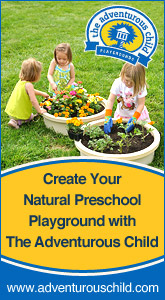ExchangeEveryDay Past Issues
 << Previous Issue
| View Past Issues | | Next Issue >>
<< Previous Issue
| View Past Issues | | Next Issue >> Voices of Children in Design Process
April 8, 2013
You can never learn less, you can only learn more.
-R. Buckminster Fuller
-R. Buckminster Fuller
"As early childhood teachers ourselves, we have always felt that the experiences and ideas of the teaching team are vital to the design process as they ‘know the space best.’ But do they really? Have adults ever crawled under the fern bushes at the bottom of the fence, or squeezed between the twisted branches of the trees behind the shed? Do they know how the mud next to the rabbit hutch crackles in a good frost? ...
"Children interact with their environment in unique and constantly changing ways that reflect the sum total of their experiences up to that point. Since their theories of how the world works are evolving on a daily basis, and they have a very different sense of physical scale, it is extremely difficult to know exactly how they view their learning environment. So how do we ensure their voices are heard in the design process?
"...We will often start in the same way as we might at a parent meeting by opening their minds to what a playscape can look like through field trips, photos, and videos of playspaces from the local area and around the world. The notion that a playground is merely a slide, some swings, and a whole lot of safety matting is still pervasive in New Zealand society. The idea that we must move beyond that to include play elements that foster whole-person development is a vital message that children seem to understand more quickly than adults!
"...Then we’ll get out lots of paper and pens and sit in the middle of the playground and just draw while we talk. Now, it’s important to note at this point that the drawings we make are simply a means to an end. As designers, what we’re really doing is listening. The conversations about play that emerge when children’s brains are relaxed and ‘distracted’ by the drawing process are where the real gold lies. While they might be drawing pirate ships with water slides, they are speaking of running and rolling, planting and harvesting, hiding, whispering, camping around the fire, being a rock star on the stage, and building a treehouse for the birds. As we listen, common threads begin to emerge about what is and is not successful in the space.
"While this is only one of the techniques that we use (in combination with careful observation of the children’s play), we find that it engages children in a way that empowers them to offer ideas in an accepting atmosphere over the entire length of the design and build process. Trust the children enough to ask for their opinions. After all, they know the space best!"
Childspaces 3.1 is a wide-ranging collection of early childhood environment images available in an easy-access CD-ROM. View over a thousand full-color digital images drawn from the work of the Childspace Institute. Childspace Institute operates five early childhood programs in Wellington, New Zealand, and conducts seminars for both national and international audiences on environment design. Use this collection of images of the work of founders Toni and Robin Christie to jump-start your creativity in creating inspiring environments for young children.
For the next two days, get FREE SHIPPING on this title!
Learn More and Purchase!
(Sale ends 11:59 PST 10/02/2014)





Comments (2)
Displaying All 2 CommentsWashington, District of Columbia, United States
Attention, all present & future members of the Working Group on Children's Rights!!! This is what is meant by children's right of PARTICIPATION. Thank you, Childspace.
Note: Children have 3 overarching rights: 1) the right to protection, 2) the right to provision (to be provided for), and 3) the right to participate in things that affect their lives. We are pretty good with #1 and #2; what we often ignore or even worse, ignore, is the right of the child to speak up and to give his or her opinion, no matter what the age of the child. Grown ups owe it to children to ask and to listen - all the time!
Dynamite Consulting, and also The Learning Collaborative
Greeley, Colorado, United States
I enjoyed the article about learning design. I grew up on a ranch several miles from town and my brothers, sisters, and myself had a natural environment in which to learn. We had pet beavers in the creek by our house, and also pet deer that lived in the meadows and the mountains. When we were swimming in the creek, we would offer fresh willows we had broken on the bank and offer them to the beavers swimming by. The would grab the willows and swim on to their dens. This was when I was only 4 years old and my brother was 6. Sometimes, believe it or not, we would try to get on the beavers' backs to go for a ride. Of course, they would dive under water to get away. They never once clawed us or tried to bite us. We would bring carrots from the house and feed them to the deer out in the meadows, or even when the deer would come up on our lawn by the house.
Very few kids got to experience the kind of early life I had and I am so grateful. I tried to give my kids the same experience even though we lived in town when I became an adult. And now I give my grandkids the same experience as much as I can. Too few children know REAL nature anymore!
Thank you.
-David Haines
Post a Comment